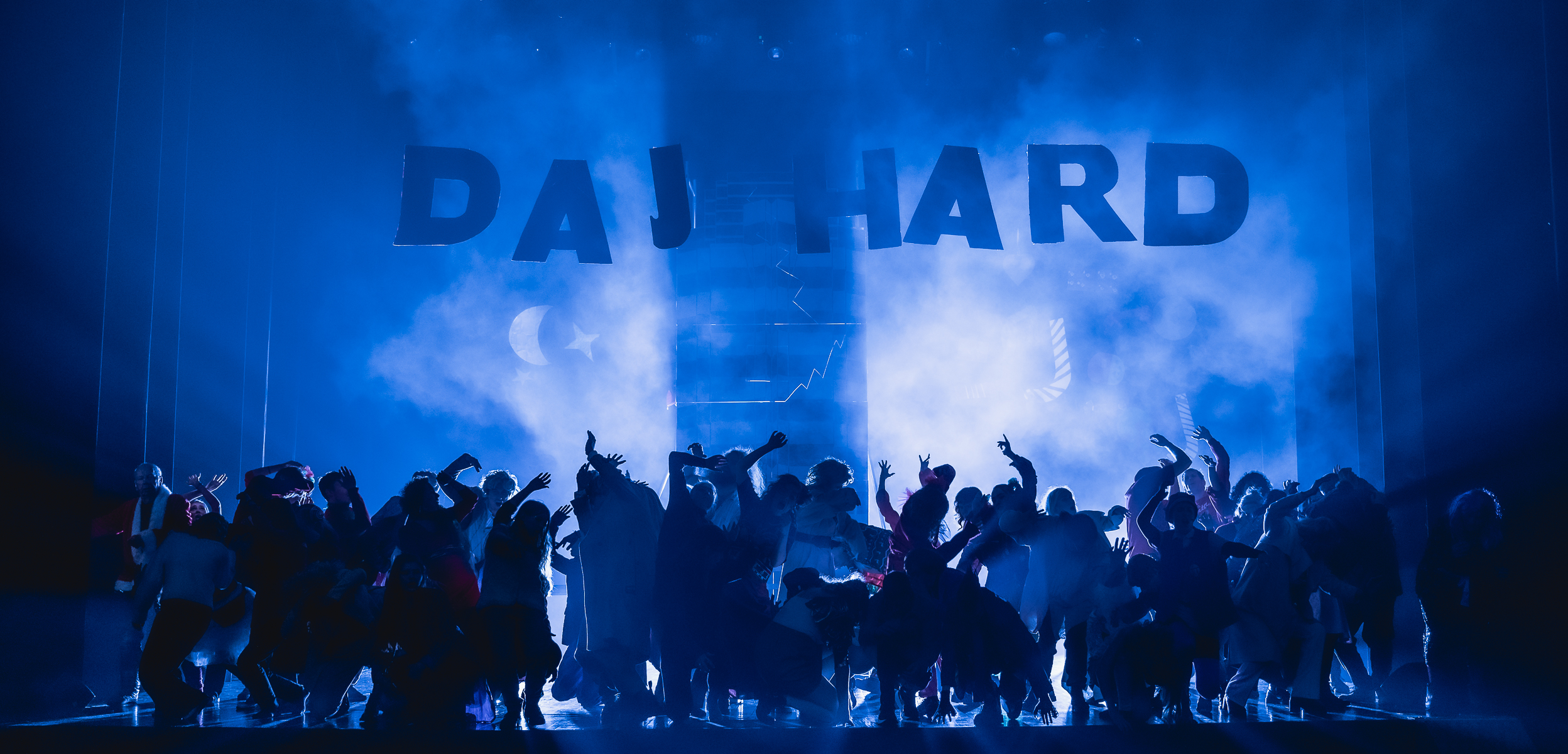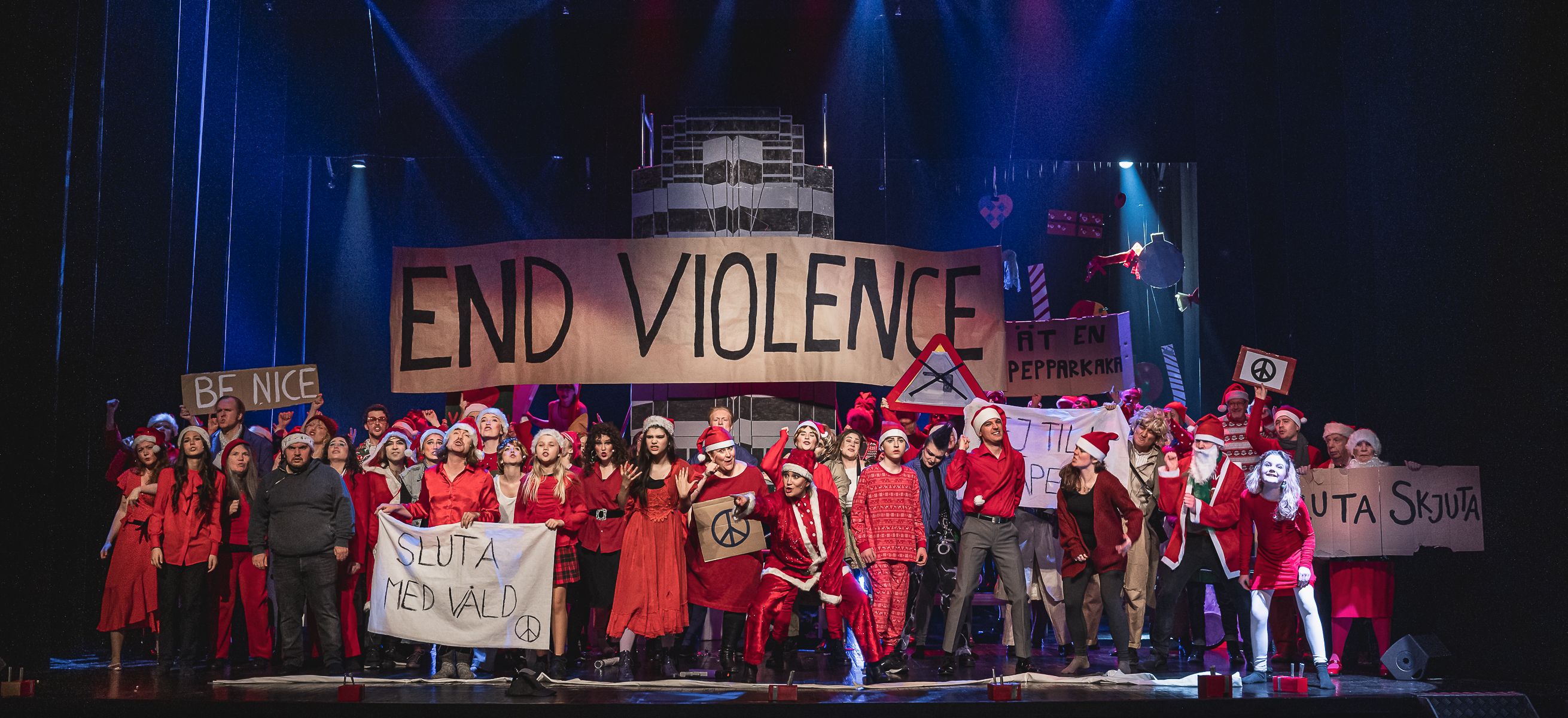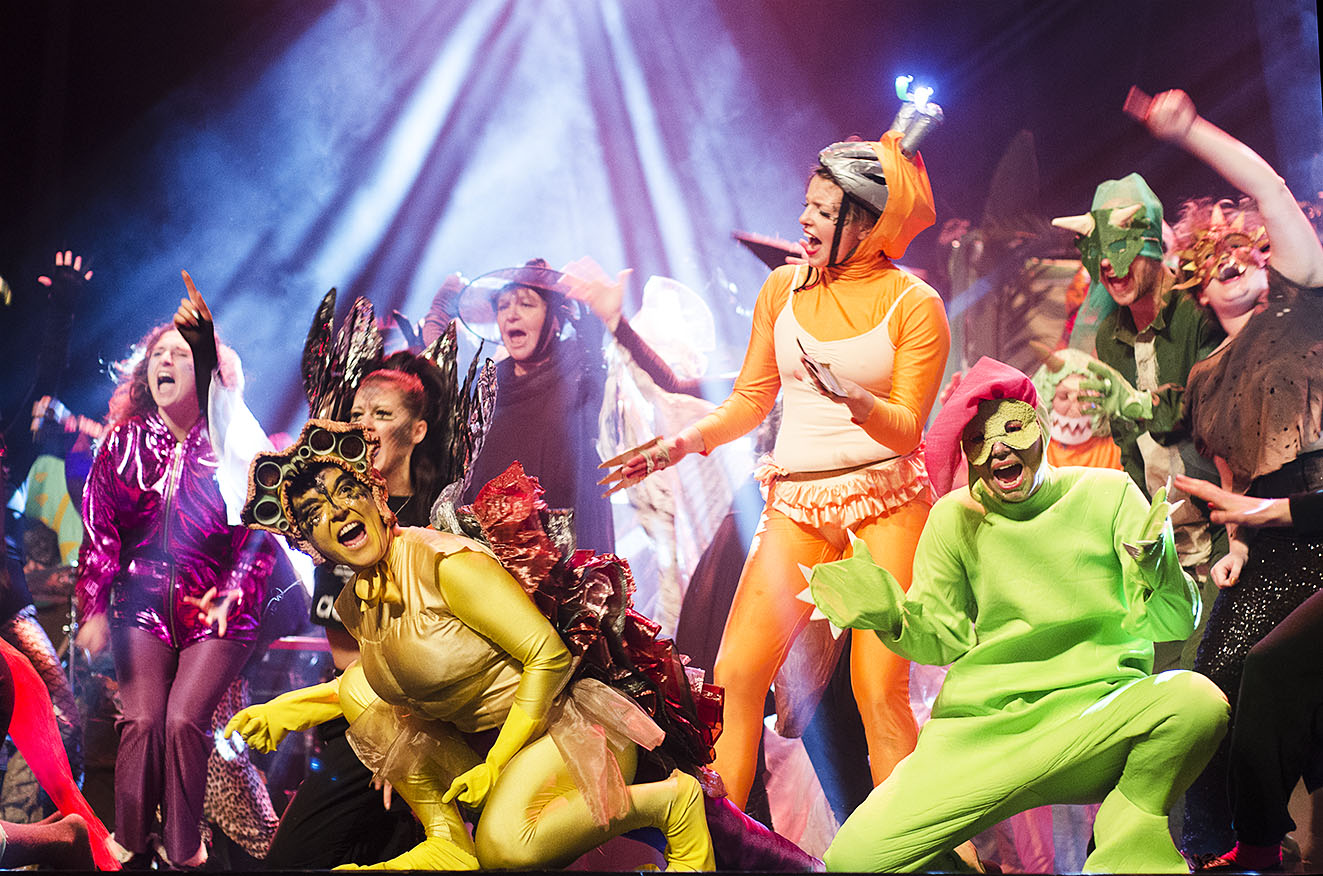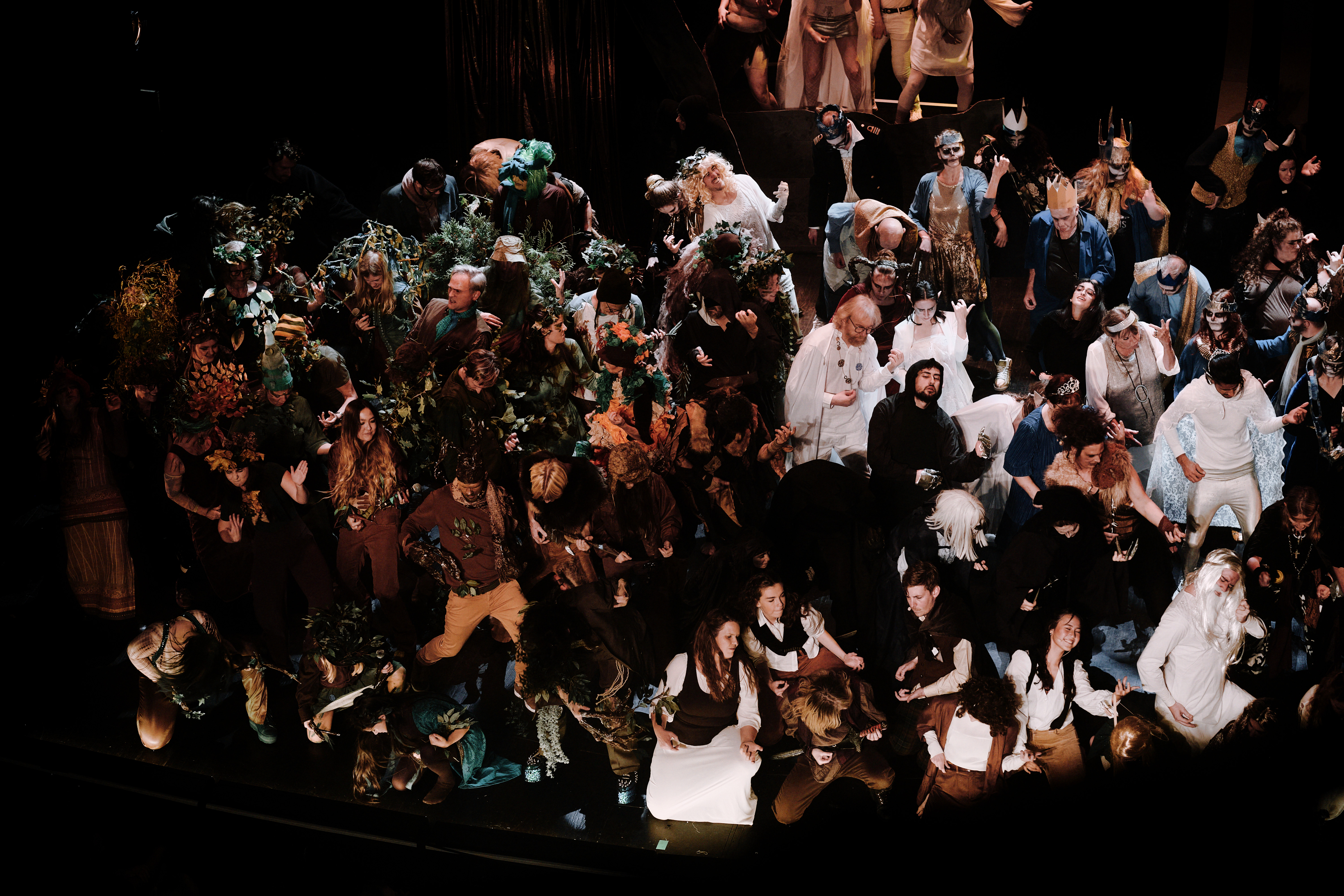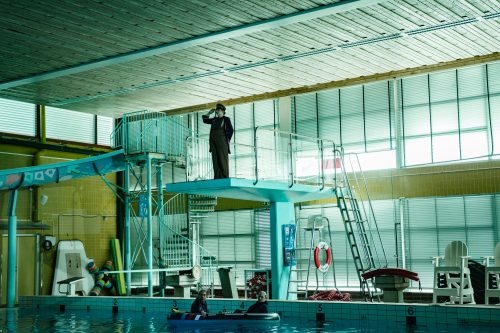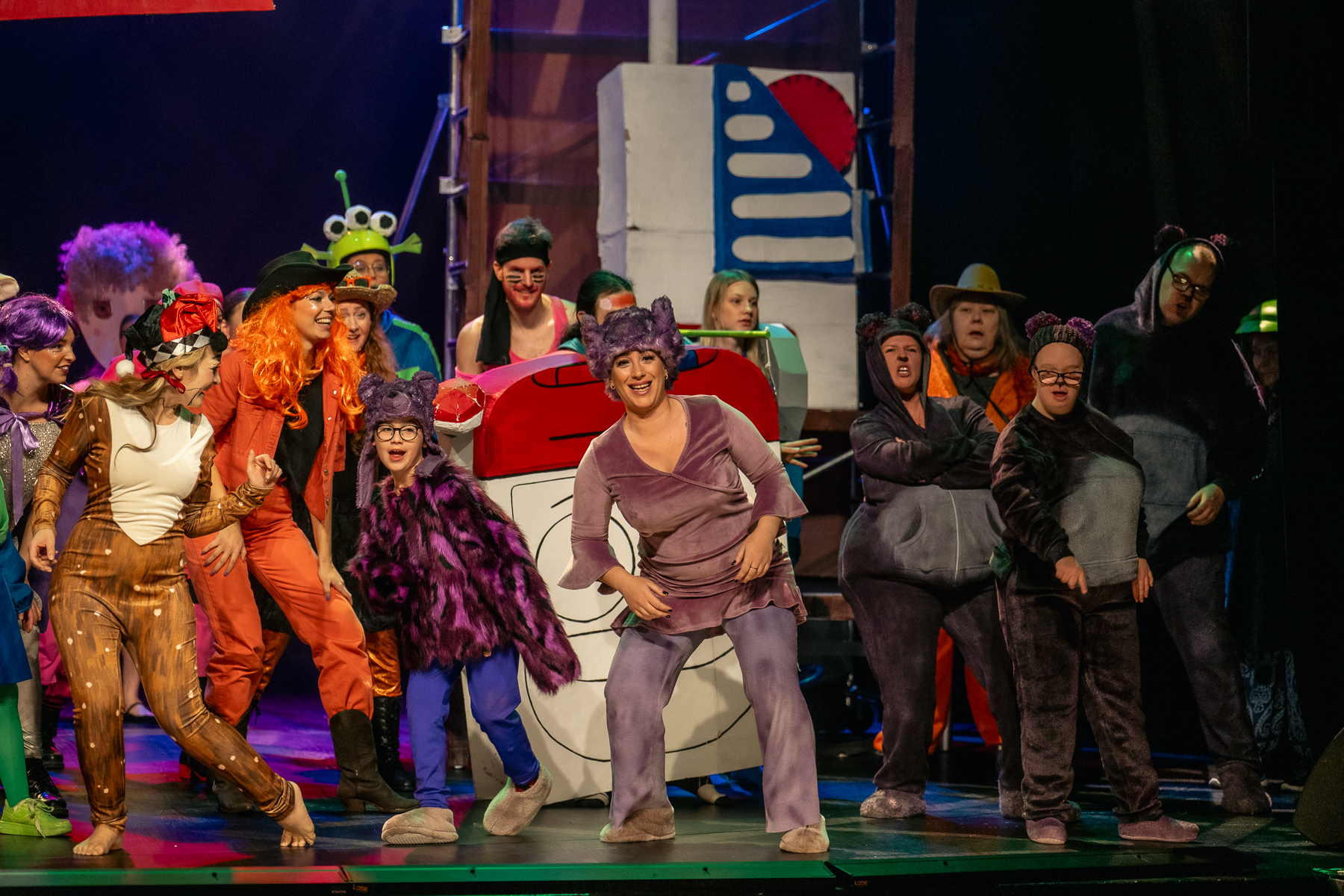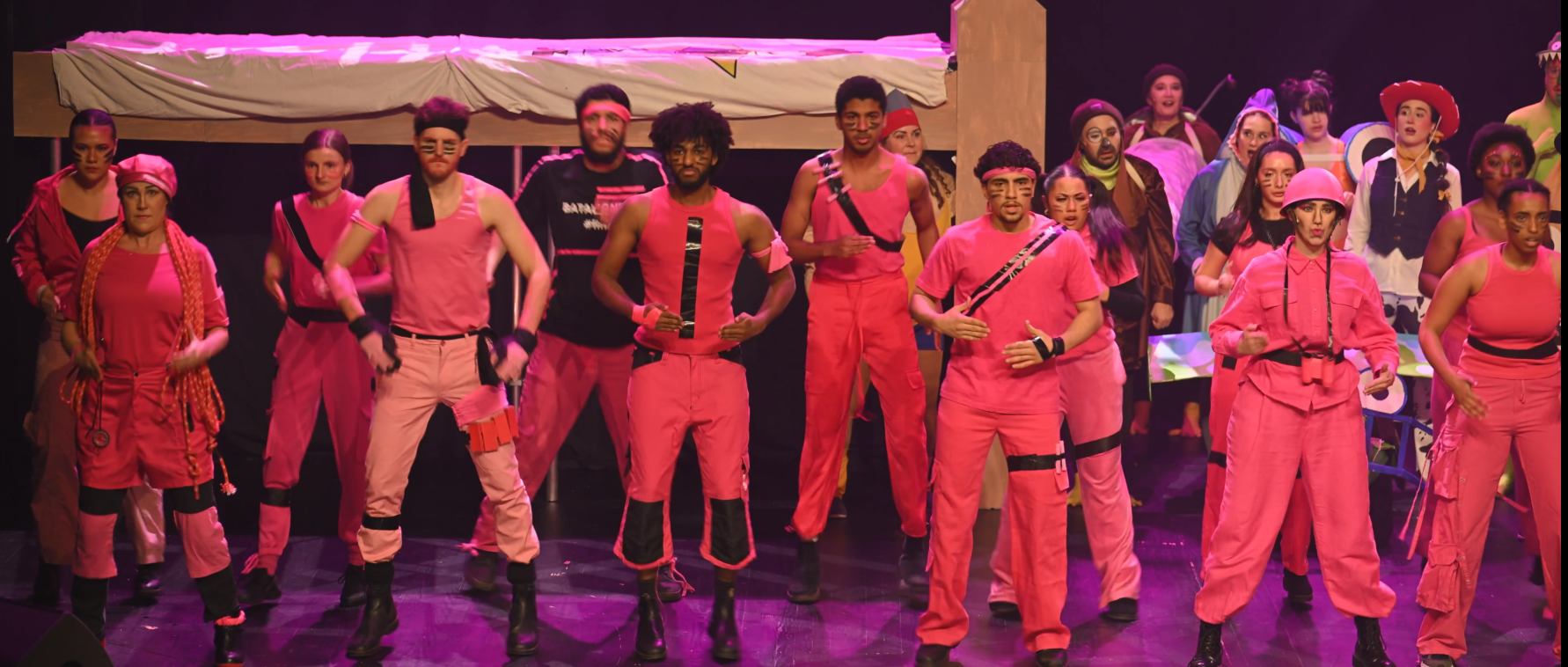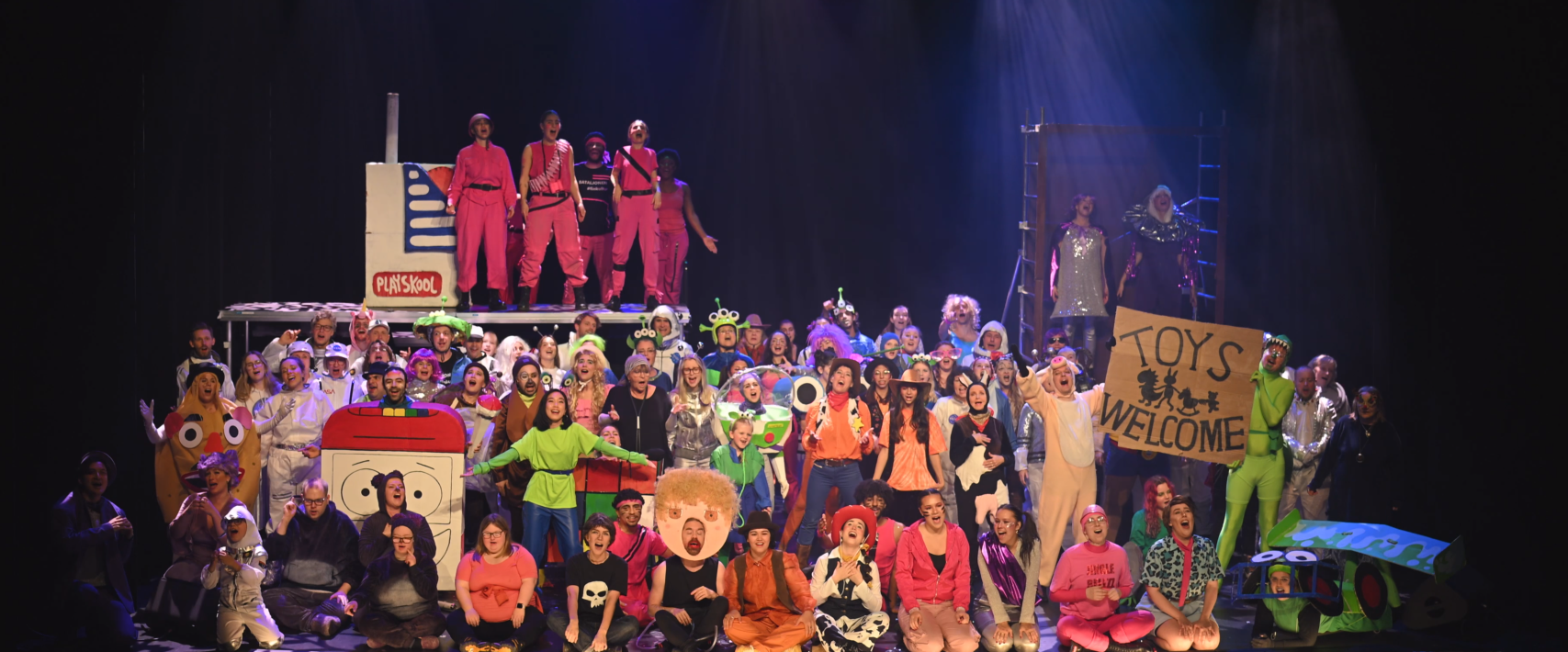Prioritising the places and people that need it the most
Bataljonen drop-in
Bataljonen drop-in - sustainable performance art for everyone
A meeting place using performing arts to combat loneliness while creating spectacular shows with people of all ages and backgrounds. Participants can join in various ways: performing, creating costumes and sets, or simply enjoying coffee and watching. The drop-in/drop-out method allows flexible participation—one can join as many rehearsals as desired, switch tasks freely, and is never required to be on stage. Someone who starts as an observer may later feel inspired to join a song.
Sweden
National
It addresses urban-rural linkages
It refers to other types of transformations (soft investment)
Yes
2024-12-20
No
No
No
As a representative of an organisation
Our project is a meeting place that uses performing arts as a tool to combat loneliness and foster connections across generations, culture backgrounds, and abilities. Through inclusive methods, we have created a platform where people from all walks of life can participate on their own terms. We´ve prioritized accessibility, ensuring that everyone could engage with the project at their own pace and comfort level through our drop-in/drop-out rehearsal method. This approach eliminated the pressure of commitment and allowed individuals to join rehearsals as they wished, whether for singing, dancing, or even just observing. Participants could shift between roles, from being on stage to crafting costumes and sets, or simply enjoying coffee and socializing.
Our project not only fostered social inclusion but also elevated the aesthetic quality of life for those involved. The act of creating and performing in grand shows together promoted a sense of belonging, boosted self-confidence, and strengthened relationships. The process of making art together encouraged people to see each other beyond societal labels and distinctions—whether in terms of age, background, or ability—which cultivated empathy, understanding, and unity.
By offering an open and welcoming space, we provided individuals with the opportunity to explore their creativity, build meaningful connections, and contribute to something greater than themselves. The work we produced was not just about the artistic experience but also about creating a space where people could overcome loneliness, feel valued, and recognize their potential as artists and human beings. This inclusive, community-driven approach generated long-term cultural benefits by making theater and art accessible to all while giving individuals the opportunity to thrive and grow in a supportive and non-judgmental environment.
Our project not only fostered social inclusion but also elevated the aesthetic quality of life for those involved. The act of creating and performing in grand shows together promoted a sense of belonging, boosted self-confidence, and strengthened relationships. The process of making art together encouraged people to see each other beyond societal labels and distinctions—whether in terms of age, background, or ability—which cultivated empathy, understanding, and unity.
By offering an open and welcoming space, we provided individuals with the opportunity to explore their creativity, build meaningful connections, and contribute to something greater than themselves. The work we produced was not just about the artistic experience but also about creating a space where people could overcome loneliness, feel valued, and recognize their potential as artists and human beings. This inclusive, community-driven approach generated long-term cultural benefits by making theater and art accessible to all while giving individuals the opportunity to thrive and grow in a supportive and non-judgmental environment.
Inclusion
Community
Accessibility
Creativity
Connection
The key objectives of our project in terms of sustainability focused on creating a lasting impact both socially and culturally, ensuring long-term accessibility, and fostering a community-driven environment. We built a platform that continued to thrive beyond the project's initial phases, offering a sustainable meeting place for diverse groups over time.
By creating an inclusive and welcoming space for people of all ages and backgrounds, we addressed social isolation and fostered a sense of belonging. Our drop-in/drop-out approach enabled individuals to participate on their own terms, reducing barriers and ensuring accessibility. Through regular collaborations with partners such as social services, schools, and cultural organizations, we developed a strong network that supported continuous outreach to marginalized communities, including the elderly, people with disabilities, and immigrants. The involvement of these groups in artistic activities not only improved their well-being but also strengthened social cohesion, creating a sustainable sense of community.
The project’s emphasis on performing arts promoted cultural exchange and broadened participation in the arts. We provided participants with the opportunity to engage in high-quality artistic production, such as creating theater, music, and dance, which contributed to a vibrant cultural ecosystem. By involving individuals who were often excluded from traditional cultural spaces, we diversified the cultural landscape and ensured that the arts were accessible to everyone. Our project challenged the traditional norms of theater and performance, fostering new and diverse voices in the artistic community. With our methods we set a precedent for how cultural projects could be transformative, reaching and empowering diverse communities. Through continued collaboration and education, we aimed to inspire others to follow this approach, making sustainable cultural engagement available to all.
By creating an inclusive and welcoming space for people of all ages and backgrounds, we addressed social isolation and fostered a sense of belonging. Our drop-in/drop-out approach enabled individuals to participate on their own terms, reducing barriers and ensuring accessibility. Through regular collaborations with partners such as social services, schools, and cultural organizations, we developed a strong network that supported continuous outreach to marginalized communities, including the elderly, people with disabilities, and immigrants. The involvement of these groups in artistic activities not only improved their well-being but also strengthened social cohesion, creating a sustainable sense of community.
The project’s emphasis on performing arts promoted cultural exchange and broadened participation in the arts. We provided participants with the opportunity to engage in high-quality artistic production, such as creating theater, music, and dance, which contributed to a vibrant cultural ecosystem. By involving individuals who were often excluded from traditional cultural spaces, we diversified the cultural landscape and ensured that the arts were accessible to everyone. Our project challenged the traditional norms of theater and performance, fostering new and diverse voices in the artistic community. With our methods we set a precedent for how cultural projects could be transformative, reaching and empowering diverse communities. Through continued collaboration and education, we aimed to inspire others to follow this approach, making sustainable cultural engagement available to all.
Our project creates an enriching and inclusive artistic space where everyone, regardless of background or ability, can participate. By prioritizing aesthetic quality and accessibility, we empower individuals to express themselves and engage in the arts.
Aesthetic Quality: We produce visually compelling and emotionally resonant performances that combine theater, music, and dance with high-quality costumes, sets, and lighting. These elements enhance storytelling and amplify underrepresented voices. By involving diverse participants in creation and performance, we ensure a dynamic, community-driven artistic experience.
Inclusive Design: Accessibility is key at every level, from physical space to participation methods. Our drop-in/drop-out model allows engagement at one’s own pace, ensuring all skill levels can contribute. The adaptable space welcomes performers, set designers, costume makers, and observers, lowering barriers and making the arts accessible to all.
Cultural Benefits: The project transforms lives by fostering confidence, skills, and artistic appreciation. Participants develop a strong sense of ownership and pride, while the community gains access to diverse, high-quality performances. This initiative strengthens social cohesion and broadens cultural participation.
Exemplar Role: We demonstrate that artistic excellence and inclusivity can coexist. By engaging a diverse audience while maintaining high standards, we set a precedent for cultural organizations. This model shows how accessible, high-quality arts can enrich society and inspire similar initiatives, ensuring that culture is available to all.
Aesthetic Quality: We produce visually compelling and emotionally resonant performances that combine theater, music, and dance with high-quality costumes, sets, and lighting. These elements enhance storytelling and amplify underrepresented voices. By involving diverse participants in creation and performance, we ensure a dynamic, community-driven artistic experience.
Inclusive Design: Accessibility is key at every level, from physical space to participation methods. Our drop-in/drop-out model allows engagement at one’s own pace, ensuring all skill levels can contribute. The adaptable space welcomes performers, set designers, costume makers, and observers, lowering barriers and making the arts accessible to all.
Cultural Benefits: The project transforms lives by fostering confidence, skills, and artistic appreciation. Participants develop a strong sense of ownership and pride, while the community gains access to diverse, high-quality performances. This initiative strengthens social cohesion and broadens cultural participation.
Exemplar Role: We demonstrate that artistic excellence and inclusivity can coexist. By engaging a diverse audience while maintaining high standards, we set a precedent for cultural organizations. This model shows how accessible, high-quality arts can enrich society and inspire similar initiatives, ensuring that culture is available to all.
Our project fosters an inclusive space where everyone, regardless of age, ability, background, or socioeconomic status, has equal access to the arts. We focus on full participation, empowerment, and representation, integrating accessibility, affordability, governance, and a new societal model of creative collaboration.
Accessibility: Our drop-in/drop-out model allows participants to engage at their own pace, ensuring flexibility for different needs. We provide various participation roles beyond performance, such as set design and costume creation. Physical spaces are designed for accessibility, with entry points, multilingual communication, and support for cognitive and physical disabilities.
Affordability: We remove financial barriers by keeping participation free, offering no-cost tickets to marginalized communities, and providing free coffee during rehearsals to foster social connection.
Inclusive Governance: The project operates on a participatory model, ensuring that all stakeholders, including participants, contribute to decision-making. This democratized structure makes the project reflective of the diverse community it serves.
New Societal Models: By bringing together people from different backgrounds, ages, and abilities, we break traditional social hierarchies. Participants are seen as creators rather than being defined by external labels. The project promotes mutual respect and shared creativity, replacing exclusion with collaboration.
Exemplary Role: Our model integrates inclusivity into every aspect, from design to governance. By prioritizing access, affordability, and shared decision-making, we inspire others to create inclusive artistic spaces. Through these efforts, we contribute to a more equitable society where the arts are accessible to all, and every individual is empowered to participate.
Accessibility: Our drop-in/drop-out model allows participants to engage at their own pace, ensuring flexibility for different needs. We provide various participation roles beyond performance, such as set design and costume creation. Physical spaces are designed for accessibility, with entry points, multilingual communication, and support for cognitive and physical disabilities.
Affordability: We remove financial barriers by keeping participation free, offering no-cost tickets to marginalized communities, and providing free coffee during rehearsals to foster social connection.
Inclusive Governance: The project operates on a participatory model, ensuring that all stakeholders, including participants, contribute to decision-making. This democratized structure makes the project reflective of the diverse community it serves.
New Societal Models: By bringing together people from different backgrounds, ages, and abilities, we break traditional social hierarchies. Participants are seen as creators rather than being defined by external labels. The project promotes mutual respect and shared creativity, replacing exclusion with collaboration.
Exemplary Role: Our model integrates inclusivity into every aspect, from design to governance. By prioritizing access, affordability, and shared decision-making, we inspire others to create inclusive artistic spaces. Through these efforts, we contribute to a more equitable society where the arts are accessible to all, and every individual is empowered to participate.
Citizens, particularly those from marginalized groups, played a key role in shaping our project’s design, activities, and impact. We ensured that those benefiting from the project were also active contributors, making their voices and experiences central to the process.
Participants engaged through a flexible drop-in/drop-out model, allowing them to join rehearsals, contribute to set design and costumes, or simply be part of the audience. Informal discussions and reflections enabled them to influence the project’s direction. Many participants became ambassadors, inviting others to join, while collaborations with social services, youth organizations, and community centers helped reach those facing exclusion due to loneliness or language barriers.
This involvement created a strong sense of ownership and empowerment, enriching the creative process with diverse ideas. The collective approach strengthened social bonds, reduced isolation, and fostered a shared purpose. A continuous feedback loop ensured ongoing improvements, keeping the project accessible and relevant. Participants from across the region not only helped establish new collaborations but also spread our methods, bringing inclusive practices into their own workplaces and communities. Many past participants applied their experiences beyond the project—teachers integrated norm-critical methods in their lessons, while HR managers introduced artistic elements in their workplaces. The project also provided an essential platform for forming social networks, allowing people to connect who might not have otherwise met. These bridges extended beyond the project, helping combat segregation and exclusion while fostering greater mutual understanding.
In conclusion, citizen involvement was crucial to the project’s success, ensuring inclusivity, strengthening community ties, and establishing a sustainable cultural initiative that continues to impact society beyond its original scope.
Participants engaged through a flexible drop-in/drop-out model, allowing them to join rehearsals, contribute to set design and costumes, or simply be part of the audience. Informal discussions and reflections enabled them to influence the project’s direction. Many participants became ambassadors, inviting others to join, while collaborations with social services, youth organizations, and community centers helped reach those facing exclusion due to loneliness or language barriers.
This involvement created a strong sense of ownership and empowerment, enriching the creative process with diverse ideas. The collective approach strengthened social bonds, reduced isolation, and fostered a shared purpose. A continuous feedback loop ensured ongoing improvements, keeping the project accessible and relevant. Participants from across the region not only helped establish new collaborations but also spread our methods, bringing inclusive practices into their own workplaces and communities. Many past participants applied their experiences beyond the project—teachers integrated norm-critical methods in their lessons, while HR managers introduced artistic elements in their workplaces. The project also provided an essential platform for forming social networks, allowing people to connect who might not have otherwise met. These bridges extended beyond the project, helping combat segregation and exclusion while fostering greater mutual understanding.
In conclusion, citizen involvement was crucial to the project’s success, ensuring inclusivity, strengthening community ties, and establishing a sustainable cultural initiative that continues to impact society beyond its original scope.
Our project engaged stakeholders at local, regional, national, and European levels, each playing a key role in its design, development, and impact.
Local Stakeholders:
We collaborated with community organizations, schools, social services, and cultural institutions to reach marginalized groups like the elderly, refugees, and people with disabilities. Local partners, such as Schyssta Kompisar and Vägen Ut, helped connect us with participants, offer logistical support, and shape outreach programs and performances to meet community needs.
Regional Stakeholders:
At the regional level, we partnered with institutions like Stora Teatern in Gothenburg and cultural organizations that helped extend the project’s reach. These partners provided infrastructure and amplified the project’s visibility, ensuring its sustainability and broadening its audience.
National Stakeholders:
National support came from cultural foundations and government initiatives focused on inclusion. They helped secure funding, shape inclusive strategies, and advocate for the project’s impact on cultural accessibility, positioning it as a model for future initiatives.
Conclusion:
Stakeholders at all levels contributed expertise, resources, and networks, ensuring the project’s success and sustainability. Local partners grounded the project in community needs, regional stakeholders helped scale its impact, national supporters provided strategic guidance and connected us to a wider cultural movement. This multi-level engagement strengthened the project’s visibility and potential for replication.
Local Stakeholders:
We collaborated with community organizations, schools, social services, and cultural institutions to reach marginalized groups like the elderly, refugees, and people with disabilities. Local partners, such as Schyssta Kompisar and Vägen Ut, helped connect us with participants, offer logistical support, and shape outreach programs and performances to meet community needs.
Regional Stakeholders:
At the regional level, we partnered with institutions like Stora Teatern in Gothenburg and cultural organizations that helped extend the project’s reach. These partners provided infrastructure and amplified the project’s visibility, ensuring its sustainability and broadening its audience.
National Stakeholders:
National support came from cultural foundations and government initiatives focused on inclusion. They helped secure funding, shape inclusive strategies, and advocate for the project’s impact on cultural accessibility, positioning it as a model for future initiatives.
Conclusion:
Stakeholders at all levels contributed expertise, resources, and networks, ensuring the project’s success and sustainability. Local partners grounded the project in community needs, regional stakeholders helped scale its impact, national supporters provided strategic guidance and connected us to a wider cultural movement. This multi-level engagement strengthened the project’s visibility and potential for replication.
Our project involved diverse disciplines to achieve its goals of inclusion, cultural access, and social integration through the arts. Experts from various fields collaborated to meet the needs of our target groups and create a meaningful cultural experience.
Theatre and Performing Arts:
Theatre professionals—directors, choreographers, and performers—created shows, adapting traditional methods to be inclusive for diverse participants.
Social Work and Inclusion:
Project managers ensured the project reached marginalized groups, providing outreach and support that made the project accessible and welcoming.
Cultural Policy and Arts Management:
Cultural policy experts and arts managers guided the strategic planning, funding, and sustainability of the project, ensuring it aligned with local and national policies.
Educational and Pedagogical Expertise:
Pedagogical experts ensured our workshops and rehearsals were inclusive, supporting diverse learning styles and fostering personal growth through our flexible participation model.
Design and Accessibility:
Designers and accessibility consultants created accessible, welcoming environments for all participants, ensuring venues, costumes, and sets were easy to interact with.
Psychology and Mental Health Support:
Psychologists and mental health professionals provided strategies to support participants emotionally, promoting well-being and addressing challenges during the artistic process.
Added Value of Interdisciplinary Collaboration:
This interdisciplinary approach led to a holistic, inclusive, and sustainable project. By integrating expertise from different fields, we created a deeply enriching experience that promotes social connection and accessibility in the arts, with potential for wider impact.
Theatre and Performing Arts:
Theatre professionals—directors, choreographers, and performers—created shows, adapting traditional methods to be inclusive for diverse participants.
Social Work and Inclusion:
Project managers ensured the project reached marginalized groups, providing outreach and support that made the project accessible and welcoming.
Cultural Policy and Arts Management:
Cultural policy experts and arts managers guided the strategic planning, funding, and sustainability of the project, ensuring it aligned with local and national policies.
Educational and Pedagogical Expertise:
Pedagogical experts ensured our workshops and rehearsals were inclusive, supporting diverse learning styles and fostering personal growth through our flexible participation model.
Design and Accessibility:
Designers and accessibility consultants created accessible, welcoming environments for all participants, ensuring venues, costumes, and sets were easy to interact with.
Psychology and Mental Health Support:
Psychologists and mental health professionals provided strategies to support participants emotionally, promoting well-being and addressing challenges during the artistic process.
Added Value of Interdisciplinary Collaboration:
This interdisciplinary approach led to a holistic, inclusive, and sustainable project. By integrating expertise from different fields, we created a deeply enriching experience that promotes social connection and accessibility in the arts, with potential for wider impact.
Our project methodology focuses on inclusion, accessibility, and flexibility, fostering creativity in a welcoming, diverse environment. The key elements are participatory engagement, flexible structure, and interdisciplinary collaboration.
Participatory Engagement
Our drop-in/drop-out model allows participants to engage at their own pace, eliminating barriers for those with time constraints or personal challenges. This approach encourages gradual involvement, where participants can start as observers and slowly become active contributors.
Flexible Structure
The project offers a range of roles (performers, designers, etc.) for participants to choose from, allowing them to contribute based on their comfort and skills. This flexibility promotes a sense of ownership and inclusivity, enabling everyone to define their role.
Interdisciplinary Collaboration
We integrate professionals such as artists, social workers, and mental health experts to create a supportive environment. This collaboration ensures high-quality art while addressing participants’ emotional and social needs.
Building Bridges Across Communities
Our project unites individuals from diverse backgrounds, including elderly people, refugees, and those with disabilities. By fostering intercultural dialogue, we create a space for mutual understanding and promote social cohesion.
Fostering Creativity and Expression
Participants are encouraged to co-create the production, allowing them to express themselves and feel a sense of belonging. Through creative work, we address social issues like loneliness and exclusion.
Sustainable Knowledge Sharing
We share our inclusive methods with other organizations through hands-on training, helping spread the values of accessibility and creativity while ensuring long-term impact.
Evaluation and Feedback
Continuous feedback from participants allows us to refine the project, ensuring it remains responsive to community needs and strengthens its social impact.
Participatory Engagement
Our drop-in/drop-out model allows participants to engage at their own pace, eliminating barriers for those with time constraints or personal challenges. This approach encourages gradual involvement, where participants can start as observers and slowly become active contributors.
Flexible Structure
The project offers a range of roles (performers, designers, etc.) for participants to choose from, allowing them to contribute based on their comfort and skills. This flexibility promotes a sense of ownership and inclusivity, enabling everyone to define their role.
Interdisciplinary Collaboration
We integrate professionals such as artists, social workers, and mental health experts to create a supportive environment. This collaboration ensures high-quality art while addressing participants’ emotional and social needs.
Building Bridges Across Communities
Our project unites individuals from diverse backgrounds, including elderly people, refugees, and those with disabilities. By fostering intercultural dialogue, we create a space for mutual understanding and promote social cohesion.
Fostering Creativity and Expression
Participants are encouraged to co-create the production, allowing them to express themselves and feel a sense of belonging. Through creative work, we address social issues like loneliness and exclusion.
Sustainable Knowledge Sharing
We share our inclusive methods with other organizations through hands-on training, helping spread the values of accessibility and creativity while ensuring long-term impact.
Evaluation and Feedback
Continuous feedback from participants allows us to refine the project, ensuring it remains responsive to community needs and strengthens its social impact.
Our project used an inclusive and participatory methodology that placed citizens, particularly those from marginalized groups, at its core. We prioritized accessibility, flexibility, and shared ownership to ensure meaningful engagement and long-term impact.
Flexible Participation: We implemented a drop-in/drop-out model, allowing participants to engage at their own pace. This approach removed barriers, making it easier for individuals with different schedules, abilities, and levels of comfort to participate. Beyond performing, participants contributed to set design, costumes, and discussions, ensuring various forms of involvement.
Community Outreach and Ambassadors: We collaborated with social services, youth organizations, and community centers to reach individuals facing social exclusion. Many participants became ambassadors, inviting others and expanding the project’s reach. This network-building approach created lasting social connections.
Empowerment Through Artistic Expression: The project encouraged participants to challenge norms and explore creative collaboration. Many carried these experiences into their professional lives—teachers integrated inclusive practices into classrooms, while HR managers introduced artistic elements into workplaces.
Continuous Feedback and Adaptation: Regular evaluations after each performance allowed us to refine methods and ensure the project remained relevant. This ongoing dialogue strengthened the initiative’s inclusivity and sustainability.
In conclusion, our methodology combined flexibility, shared leadership, and artistic collaboration to foster empowerment, strengthen community ties, and create lasting cultural impact.
Flexible Participation: We implemented a drop-in/drop-out model, allowing participants to engage at their own pace. This approach removed barriers, making it easier for individuals with different schedules, abilities, and levels of comfort to participate. Beyond performing, participants contributed to set design, costumes, and discussions, ensuring various forms of involvement.
Community Outreach and Ambassadors: We collaborated with social services, youth organizations, and community centers to reach individuals facing social exclusion. Many participants became ambassadors, inviting others and expanding the project’s reach. This network-building approach created lasting social connections.
Empowerment Through Artistic Expression: The project encouraged participants to challenge norms and explore creative collaboration. Many carried these experiences into their professional lives—teachers integrated inclusive practices into classrooms, while HR managers introduced artistic elements into workplaces.
Continuous Feedback and Adaptation: Regular evaluations after each performance allowed us to refine methods and ensure the project remained relevant. This ongoing dialogue strengthened the initiative’s inclusivity and sustainability.
In conclusion, our methodology combined flexibility, shared leadership, and artistic collaboration to foster empowerment, strengthen community ties, and create lasting cultural impact.
Our project is flexible and scalable, with several elements that can be replicated or transferred:
Drop-in/Drop-out Participation Model: Participants can join rehearsals based on their schedule, helping overcome social and health challenges. This model is adaptable to community-based projects targeting marginalized groups.
Inclusive Artistic Methods: Our hands-on approach to creating art, including performances and design, is transferable to other initiatives that aim to engage diverse communities and promote personal expression.
Interdisciplinary Collaboration: Integrating artists, social workers, and educators creates a holistic environment that can be applied in schools, hospitals, and care centers to support emotional well-being through creativity.
Knowledge Sharing & Training: Our sustainability plan involves sharing our inclusive practices through training and workshops. This helps empower organizations to adopt similar approaches globally, in arts, education, or social services.
Workshops & Community Outreach: Our workshops target marginalized groups such as refugees, elderly, and people with disabilities. Other communities can replicate this model to foster relationships and create access to cultural activities.
Social Impact and Evaluation Tools: Our feedback and evaluation methods help assess the project’s success in inclusion. These tools can be adapted to measure impact and refine approaches in other projects.
Flexibility of Artistic Content: The project’s art, including performances, can be adapted to various contexts and art forms like visual arts or literature, meeting community needs.
Fostering Intergenerational Interaction: Our intergenerational approach, which can be applied in schools or senior centers, helps bridge generational gaps and encourages empathy.
In summary, the project’s key elements, flexibility, collaboration, inclusivity, and knowledge sharing, are adaptable in different settings, creating a ripple effect of social cohesion
Drop-in/Drop-out Participation Model: Participants can join rehearsals based on their schedule, helping overcome social and health challenges. This model is adaptable to community-based projects targeting marginalized groups.
Inclusive Artistic Methods: Our hands-on approach to creating art, including performances and design, is transferable to other initiatives that aim to engage diverse communities and promote personal expression.
Interdisciplinary Collaboration: Integrating artists, social workers, and educators creates a holistic environment that can be applied in schools, hospitals, and care centers to support emotional well-being through creativity.
Knowledge Sharing & Training: Our sustainability plan involves sharing our inclusive practices through training and workshops. This helps empower organizations to adopt similar approaches globally, in arts, education, or social services.
Workshops & Community Outreach: Our workshops target marginalized groups such as refugees, elderly, and people with disabilities. Other communities can replicate this model to foster relationships and create access to cultural activities.
Social Impact and Evaluation Tools: Our feedback and evaluation methods help assess the project’s success in inclusion. These tools can be adapted to measure impact and refine approaches in other projects.
Flexibility of Artistic Content: The project’s art, including performances, can be adapted to various contexts and art forms like visual arts or literature, meeting community needs.
Fostering Intergenerational Interaction: Our intergenerational approach, which can be applied in schools or senior centers, helps bridge generational gaps and encourages empathy.
In summary, the project’s key elements, flexibility, collaboration, inclusivity, and knowledge sharing, are adaptable in different settings, creating a ripple effect of social cohesion
The project addresses several global challenges by providing local solutions that promote inclusion and social cohesion. One major challenge is social isolation, which is prevalent across various demographics, including the elderly, immigrants, and marginalized groups. By creating an open and accessible platform for people from different backgrounds, including age, social, geographical, and functional differences, the project fosters connections between individuals who might otherwise remain isolated. The drop-in/drop-out method allows participants to join based on their own capacity, reducing barriers to entry and promoting continuous engagement.
Another global challenge is inequality, particularly the unequal access to culture and artistic expression. The project works to break down the cultural barriers by making high-quality, large-scale performing arts accessible to everyone, regardless of their background or personal circumstances. By welcoming participants to engage in creating, performing, or experiencing theater, we are helping to democratize the arts and provide opportunities for those traditionally excluded from cultural spaces.
Additionally, the project challenges and addresses the global issue of cultural exclusion, creating a space for diverse voices and perspectives in the cultural sector. This inclusive approach highlights the importance of diversity in the arts, allowing for new narratives and artistic expressions to emerge from underrepresented communities.
Through this approach, the project not only contributes to local community-building but also engages with broader global issues such as inequality, exclusion, and the need for accessible cultural platforms, demonstrating how arts and culture can be powerful tools for social change and cohesion.
Another global challenge is inequality, particularly the unequal access to culture and artistic expression. The project works to break down the cultural barriers by making high-quality, large-scale performing arts accessible to everyone, regardless of their background or personal circumstances. By welcoming participants to engage in creating, performing, or experiencing theater, we are helping to democratize the arts and provide opportunities for those traditionally excluded from cultural spaces.
Additionally, the project challenges and addresses the global issue of cultural exclusion, creating a space for diverse voices and perspectives in the cultural sector. This inclusive approach highlights the importance of diversity in the arts, allowing for new narratives and artistic expressions to emerge from underrepresented communities.
Through this approach, the project not only contributes to local community-building but also engages with broader global issues such as inequality, exclusion, and the need for accessible cultural platforms, demonstrating how arts and culture can be powerful tools for social change and cohesion.
The project has delivered significant outcomes, fostering inclusion, participation, and community building through the arts. Direct beneficiaries, including elderly individuals, people with and without disabilities, refugees, permanent residents, and marginalized youth, have seen improvements in their social well-being, self-esteem, and sense of belonging. By offering a welcoming and accessible space, the project has helped reduce isolation and created opportunities for individuals from diverse backgrounds to connect, building stronger community ties.
A key result is the creation of an ongoing, inclusive meeting space where people of all ages, backgrounds, and abilities can come together to create and experience art. The drop-in/drop-out model allows participants to engage in the artistic process at their own pace, whether through performances, costume making, or attending rehearsals. This flexibility has made the arts more accessible, especially for those who might otherwise not have had the opportunity to participate.
The project has had a profound cultural impact by bringing together diverse groups, contributing to the democratization of the arts. It has broken down traditional barriers to participation, allowing participants to gain artistic skills in areas such as singing, dancing, and acting, while also boosting their confidence and fostering personal growth through creative expression.
In addition to the direct benefits for participants, the project has had broader impacts on the community. It has raised awareness of the importance of inclusivity in the arts and emphasized the need for accessible, welcoming spaces for all. The project’s collaborative nature has strengthened partnerships with local organizations, amplifying its impact beyond the immediate participants.
In summary, the project has enhanced social cohesion, reduced isolation, and contributed to a more inclusive cultural landscape.
A key result is the creation of an ongoing, inclusive meeting space where people of all ages, backgrounds, and abilities can come together to create and experience art. The drop-in/drop-out model allows participants to engage in the artistic process at their own pace, whether through performances, costume making, or attending rehearsals. This flexibility has made the arts more accessible, especially for those who might otherwise not have had the opportunity to participate.
The project has had a profound cultural impact by bringing together diverse groups, contributing to the democratization of the arts. It has broken down traditional barriers to participation, allowing participants to gain artistic skills in areas such as singing, dancing, and acting, while also boosting their confidence and fostering personal growth through creative expression.
In addition to the direct benefits for participants, the project has had broader impacts on the community. It has raised awareness of the importance of inclusivity in the arts and emphasized the need for accessible, welcoming spaces for all. The project’s collaborative nature has strengthened partnerships with local organizations, amplifying its impact beyond the immediate participants.
In summary, the project has enhanced social cohesion, reduced isolation, and contributed to a more inclusive cultural landscape.

